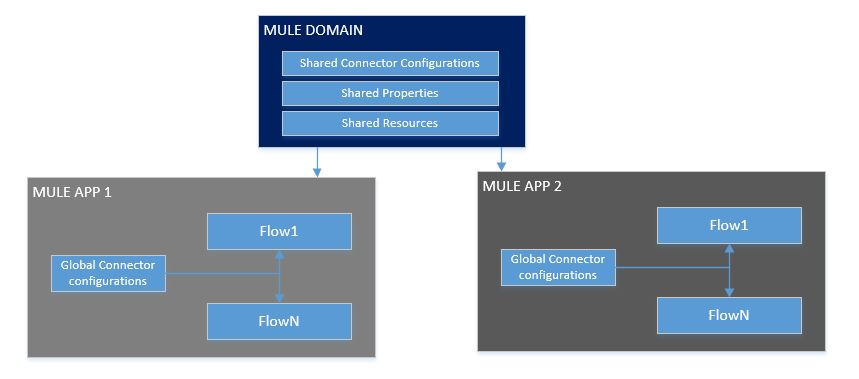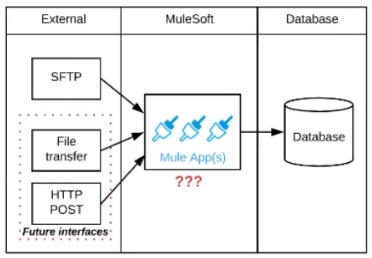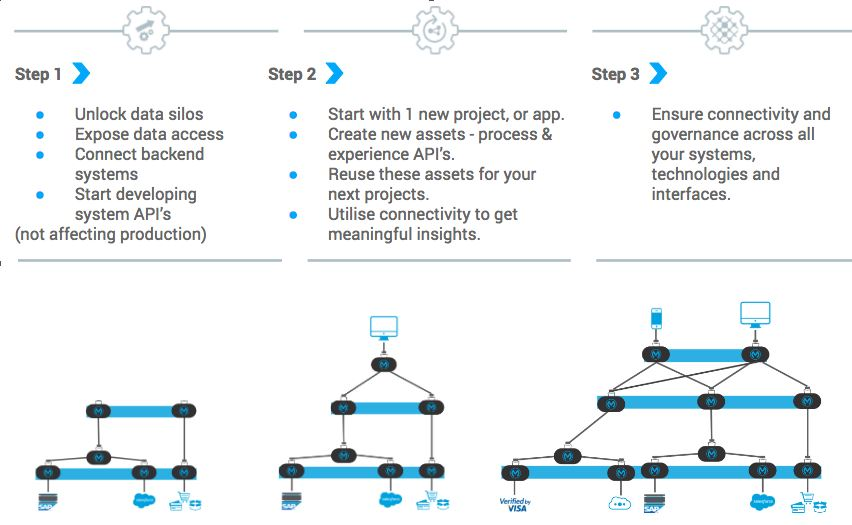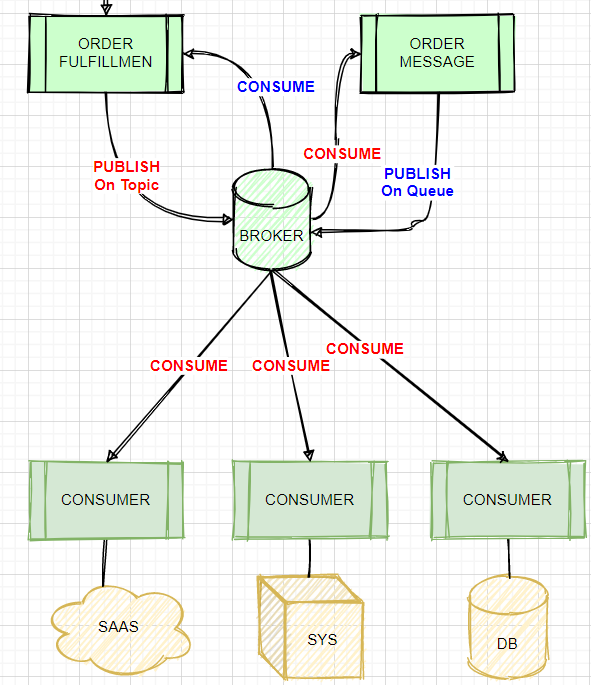Salesforce Certified MuleSoft Platform Integration Architect (Mule-Arch-202) Exam Practice Test
What is not true about Mule Domain Project?
Answer : C
*Mule Domain Project is ONLY available for customer-hosted Mule runtimes, but not for Anypoint Runtime Fabric
*Mule domain project is available for Hybrid and Private Cloud (PCE). Rest all provide application isolation and can't support domain project.
What is Mule Domain Project?
*A Mule Domain Project is implemented to configure the resources that are shared among different projects. These resources can be used by all the projects associated with this domain. Mule applications can be associated with only one domain, but a domain can be associated with multiple projects. Shared resources allow multiple development teams to work in parallel using the same set of reusable connectors. Defining these connectors as shared resources at the domain level allows the team to: - Expose multiple services within the domain through the same port. - Share the connection to persistent storage. - Share services between apps through a well-defined interface. - Ensure consistency between apps upon any changes because the configuration is only set in one place.
*Use domains Project to share the same host and port among multiple projects. You can declare the http connector within a domain project and associate the domain project with other projects. Doing this also allows to control thread settings, keystore configurations, time outs for all the requests made within multiple applications. You may think that one can also achieve this by duplicating the http connector configuration across all the applications. But, doing this may pose a nightmare if you have to make a change and redeploy all the applications.
*If you use connector configuration in the domain and let all the applications use the new domain instead of a default domain, you will maintain only one copy of the http connector configuration. Any changes will require only the domain to the redeployed instead of all the applications.
You can start using domains in only three steps:
1) Create a Mule Domain project
2) Create the global connector configurations which needs to be shared across the applications inside the Mule Domain project
3) Modify the value of domain in mule-deploy.properties file of the applications

A travel company wants to publish a well-defined booking service API to be shared with its business partners. These business partners have agreed to ONLY consume SOAP services and they want to get the service contracts in an easily consumable way before they start any development. The travel company will publish the initial design documents to Anypoint Exchange, then share those documents with the business partners. When using an API-led approach, what is the first design document the travel company should deliver to its business partners?
Answer : A
SOAPAPI specifications are provided as WSDL. Design center doesn't provide the functionality to create WSDL file. Hence WSDL needs to be created using XML editor
When designing an upstream API and its implementation, the development team has been advised to not set timeouts when invoking downstream API. Because the downstream API has no SLA that can be relied upon. This is the only donwstream API dependency of that upstream API. Assume the downstream API runs uninterrupted without crashing. What is the impact of this advice?
Answer : B
An SLA for the upstream API CANNOT be provided.
A project team uses RAML specifications to document API functional requirements and deliver API definitions. As per the current legal requirement, all designed API definitions to be augmented with an additional non-functional requirement to protect the services from a high rate of requests according to define service level agreements.
Assuming that the project is following Mulesoft API governance and policies, how should the project team convey the necessary non-functional requirement to stakeholders?
Answer : D
Refer to the exhibit.

A business process involves the receipt of a file from an external vendor over SFTP. The file needs to be parsed and its content processed, validated, and ultimately persisted to a database. The delivery mechanism is expected to change in the future as more vendors send similar files using other mechanisms such as file transfer or HTTP POST.
What is the most effective way to design for these requirements in order to minimize the impact of future change?
Answer : C
* Scatter-Gather is used for parallel processing, to improve performance. In this scenario, input files are coming from different vendors so mostly at different times. Goal here is to minimize the impact of future change. So scatter Gather is not the correct choice.
* If we use 1 API to receive all files from different Vendors, any new vendor addition will need changes to that 1 API to accommodate new requirements. So Option A and C are also ruled out.
* Correct answer is Create an API that receives the file and invokes a Process API with the data contained in the file, then have the Process API process the data using a MuleSoft Batch Job and other System APIs as needed. Answer to this question lies in the API led connectivity approach.
* API-led connectivity is a methodical way to connect data to applications through a series of reusable and purposeful modern APIs that are each developed to play a specific role -- unlock data from systems, compose data into processes, or deliver an experience. System API : System API tier, which provides consistent, managed, and secure access to backend systems. Process APIs : Process APIs take core assets and combines them with some business logic to create a higher level of value. Experience APIs : These are designed specifically for consumption by a specific end-user app or device.
So in case of any future plans , organization can only add experience API on addition of new Vendors, which reuse the already existing process API. It will keep impact minimal.

A mule application is being designed to perform product orchestration. The Mule application needs to join together the responses from an inventory API and a Product Sales History API with the least latency.
To minimize the overall latency. What is the most idiomatic (used for its intended purpose) design to call each API request in the Mule application?
Answer : B
Scatter-Gather sends a request message to multiple targets concurrently. It collects the responses from all routes, and aggregates them into a single message.
An Order microservice and a Fulfillment microservice are being designed to communicate with their dients through message-based integration (and NOT through API invocations).
The Order microservice publishes an Order message (a kind of command message) containing the details of an order to be fulfilled. The intention is that Order messages are only consumed by one Mute application, the Fulfillment microservice.
The Fulfilment microservice consumes Order messages, fulfills the order described therein, and then publishes an OrderFulfilted message (a kind of event message). Each OrderFulfilted message can be consumed by any interested Mule application, and the Order microservice is one such Mute application.
What is the most appropriate choice of message broker(s) and message destination(s) in this scenario?
Answer : B
* If you need to scale a JMS provider/ message broker, - add nodes to scale it horizontally or - add memory to scale it vertically * Cons of adding another JMS provider/ message broker: - adds cost. - adds complexity to use two JMS brokers - adds Operational overhead if we use two brokers, say, ActiveMQ and IBM MQ * So Two options that mention to use two brokers are not best choice. * It's mentioned that 'The Fulfillment microservice consumes Order messages, fulfills the order described therein, and then publishes an OrderFulfilled message. Each OrderFulfilled message can be consumed by any interested Mule application.' - When you publish a message on a topic, it goes to all the subscribers who are interested - so zero to many subscribers will receive a copy of the message. - When you send a message on a queue, it will be received by exactly one consumer. * As we need multiple consumers to consume the message below option is not valid choice: 'Order messages are sent to an Anypoint MQ exchange. OrderFulfilled messages are sent to an Anypoint MQ queue. Both microservices interact with Anypoint MQ as the message broker, which must therefore scale to support the load of both microservices' * Order messages are only consumed by one Mule application, the Fulfillment microservice, so we will publish it on queue and OrderFulfilled message can be consumed by any interested Mule application so it need to be published on Topic using same broker. * Correct Answer:
